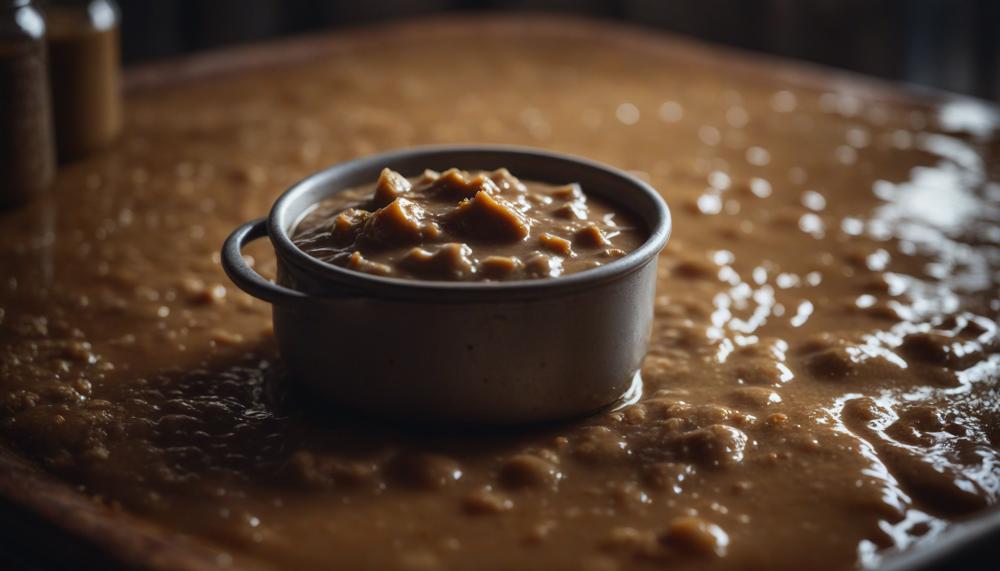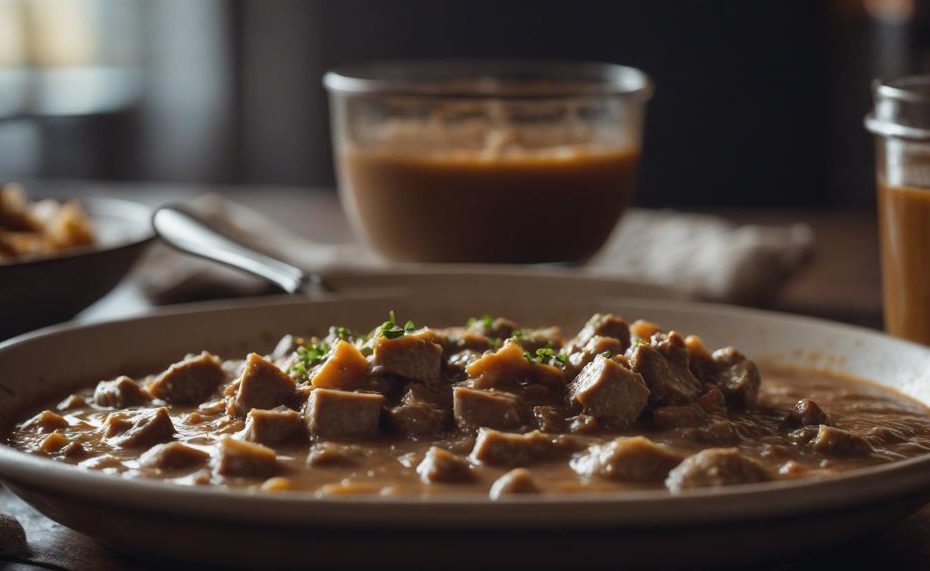The holiday season brings joy, family gatherings, and, of course, a feast of delicious foods. One of the staples that often graces the table is gravy. However, dealing with leftover gravy can be a bit of a challenge. Whether you’ve made too much or can’t finish what’s left, proper disposal is key to preventing plumbing issues and minimizing environmental impact.
Key Takeaways:
- Trash or Compost: Throw leftover gravy in the trash or mix it with organic materials for composting.
- Freeze for Later: Preserve the flavor of leftover gravy by freezing it.
- Separate Fat and Liquid: Remove excess fat and grease before disposal.
- Avoid the Sink: Never pour gravy down the sink or toilet to prevent plumbing problems.
- Donate: Consider donating extra gravy to homeless shelters or soup kitchens.
So, let’s ensure that your holiday cleanup is as smooth as your gravy, without the hassle of clogged pipes or environmental harm.

Contents
Gravy and its Importance
Proper disposal of leftover gravy is essential for several reasons:
Prevent Plumbing Problems
Pouring gravy down the sink or toilet can lead to severe plumbing issues. Fat and grease solidify in pipes, causing blockages that may require costly repairs.
Environmental Impact
Incorrect disposal of gravy contributes to landfill waste. By composting or disposing of it properly, you can reduce this impact and promote a healthier environment.
Composting Benefits
Leftover gravy can be composted, turning it into nutrient-rich soil. This eco-friendly option helps gardens thrive and reduces waste.
Health and Hygiene
Improper disposal of gravy, especially meat-based, can attract pests and create unsanitary conditions. Proper disposal helps maintain a clean and healthy living environment.
Cost Savings
Freezing leftover gravy for later use not only saves money but also ensures you have a ready supply of delicious gravy without the need for fresh preparation.
Community Aid
Donating excess gravy to local shelters or soup kitchens helps support those in need and prevents waste.
Difference between Gravy, Fats, and Oil
Gravy, fats, and oil are staples in cooking but differ significantly in their composition, consistency, and disposal impact. Here’s a detailed breakdown of these differences and their implications for disposal.
| Substance | Composition | Disposal Impact |
| Gravy | Made from meat juices or broth thickened with starch (flour or cornstarch) and seasoned. | Thick consistency can clog drains if poured down sinks. Should be cooled and disposed of in the trash. |
| Fats | Solid at room temperature, derived from animal sources (e.g., meat, butter, cheese). | Can solidify in pipes causing blockages. Best disposed of by letting it harden and then placing it in the trash. |
| Oil | Liquid at room temperature, extracted from plant sources (e.g., olives, soybeans, sunflowers). | Coats pipes and causes buildup over time. Should be collected in a container and taken to a recycling centre. |
Consistency and Viscosity
- Gravy: Its thick, viscous nature due to starch can easily cause clogs in plumbing if disposed of down the drain. To avoid this, gravy should be cooled, solidified, and then thrown away with general waste.
- Fats: Solid at room temperature, fats melt when heated but revert to a solid state as they cool. This trait makes them a frequent cause of pipe blockages. The recommended disposal method is to let fats harden and then scrape them into the trash.
- Oil: Always liquid, oil doesn’t solidify but coats the inside of pipes, gradually leading to buildups and clogs. Proper disposal involves collecting used oil in a sealed container and taking it to a designated recycling centre.
Environmental Impact
Improper disposal of these substances poses significant environmental risks. When gravy, fats, or oil enter the water system, they can pollute waterways, harm aquatic life, and disrupt local ecosystems.
Additionally, they contribute to clogs in sewage systems, potentially leading to overflows and public health issues.
Practical Disposal Methods
- Gravy: Allow to cool and solidify, then scrape into the trash. Avoid pouring down sinks or toilets.
- Fats: Let harden at room temperature and dispose of in the trash. For large quantities, consider using a container.
- Oil: Collect used oil in a container and take it to a recycling centre. Never pour it down the drain.
For more detailed information on proper disposal methods, you can visit this guide on household waste disposal from the EPA.
Why You Shouldn’t Pour Gravy Down the Drain?
The short answer: pouring gravy down the drain can cause significant plumbing issues, environmental harm, and costly repairs. Here’s why:
| Consequences | Description | Importance |
| Clogged Pipes | Gravy contains fats and oils that solidify when cooled, leading to blockages in the plumbing system. | Avoids expensive plumbing repairs and prevents pipe damage. |
| Environmental Impact | Fats, oils, and grease (FOG) from gravy can enter the sewer system, harming aquatic life and contributing to water pollution. | Protects local water sources and ecosystems from contamination. |
| Health Risks | Backed-up drains can foster the growth of harmful bacteria and mold, posing health risks to your household. | Maintains a healthy and safe living environment. |
| Increased Waste | Improper disposal leads to more waste processing in treatment plants, increasing operational costs and resource use. | Reduces waste treatment burden and supports sustainable practices. |
Proper Disposal Methods
- Trash Disposal: Allow gravy to cool and solidify, then scrape it into the trash. This method is simple and effective.
- Composting: If the gravy is plant-based, it can be added to a compost pile. This eco-friendly option helps reduce landfill waste.
- Freezing for Later Use: Store leftover gravy in an airtight container and freeze it for future meals. This not only prevents waste but also provides a convenient ingredient for later.
- Absorption Method: Use paper towels or newspapers to soak up excess gravy before disposal in the trash. This method helps manage small amounts effectively.
Environmentally-Friendly Gravy Disposal Methods
There are several effective ways to dispose of leftover gravy that are kind to the environment:
Composting
Composting transforms food waste into nutrient-rich soil. Dilute the gravy with water to avoid attracting pests and unpleasant odors. Add this mixture to your compost bin along with other compostable materials such as vegetable scraps and yard waste.
Regularly turn the compost to facilitate proper aeration and decomposition. This method enriches your garden soil and reduces landfill waste.
| Step | Action | Notes |
| 1 | Dilute the gravy with water | Prevents odor and pests |
| 2 | Add to compost bin | Mix with other compostables |
| 3 | Turn compost regularly | Ensures proper aeration |
Using as Marinade or Base
Leftover gravy can serve as a delicious marinade for meats or vegetables, or as a base for soups and stews. This method minimizes waste and adds a flavorful twist to your meals.
| Usage | Description | Benefit |
| Marinade | Use gravy to marinate meats or vegetables | Reduces waste, adds flavor |
| Soup/Stew Base | Incorporate gravy into soups or stews | Enhances taste, minimizes waste |
Freezing
If you’re not ready to use the gravy immediately, freeze it for future use. Pour the gravy into an ice cube tray, freeze, then transfer the frozen cubes to a freezer-safe container. This method saves resources and ensures you have a ready supply of gravy for later use.
| Step | Action | Notes |
| 1 | Pour gravy into ice cube trays | Portion control |
| 2 | Freeze until solid | Prevents spoilage |
| 3 | Transfer to freezer-safe container | Long-term storage |
Avoid Harmful Disposal
Avoid pouring gravy down the sink, as it can solidify and block pipes, causing environmental damage. Additionally, do not dispose of gravy on the ground or into water sources, which can harm wildlife and pollute the environment.
| Action to Avoid | Reason | Environmental Impact |
| Pouring down the sink | Clogs pipes | Harms plumbing and environment |
| Disposing on ground/in water | Pollutes environment | Harms wildlife and water quality |
For more detailed guidance on composting and eco-friendly practices, visit EPA’s Home Composting Guide.
Gravy Disposal Safety Tips
When disposing of leftover gravy, follow these safety tips to ensure proper handling and disposal:
| Storage | Hand Hygiene | Temperature |
| Refrigerate leftover gravy within two hours of cooking. Use airtight containers or sealed bags, and label with the date. | Wash hands and utensils with hot, soapy water before and after handling gravy to prevent bacterial contamination. | Cool gravy completely before freezing. Reheat to an internal temperature of 165°F (74°C) to kill bacteria. |
| Disposal Method | Fat Separation | Environmental Considerations |
| Do not pour gravy down the sink or toilet. Scrape excess into a trash bag or compost bin. Use a compost bin for small amounts of gravy. | Separate fat from liquid in meat-based gravies. Soak up excess fat with paper towels or newspaper before disposal. | Avoid plumbing issues and environmental harm by not pouring gravy down drains. Consider composting to create nutrient-rich soil. |
| Safety Precautions | Additional Resources | Donations |
| Discard gravy left out for more than two hours. If unsure about safety, err on the side of caution and throw it out. | Consult local health departments or food safety experts for specific guidelines. Check resources like FoodSafety.gov. | Consider donating extra gravy to homeless shelters or soup kitchens, ensuring it meets their safety standards. |
Proper disposal of leftover gravy prevents foodborne illnesses and environmental issues.
Benefits of Disposing of Gravy Safely
The importance of disposing of leftover gravy safely lies in preventing health risks and environmental hazards.
Health Risks
Leftover gravy, rich in fats and meat drippings, provides an ideal environment for bacteria to thrive. When not stored or disposed of properly, it can lead to:
- Foodborne Illnesses: Bacteria such as Salmonella and E. coli can multiply rapidly in gravy left at room temperature, increasing the risk of food poisoning. The CDC reports that foodborne illnesses impact 48 million people in the US annually, leading to 128,000 hospitalizations and 3,000 deaths.
- Pest Attraction: Gravy can attract pests like rodents and insects. These pests can carry harmful bacteria and contaminate other food items and surfaces in your home, exacerbating the risk of illness.
Environmental Hazards
Improper disposal of gravy can severely affect the environment:
- Clogged Drains and Pipes: Pouring gravy down the sink leads to fat and oil build-up, which can solidify and cause blockages in plumbing systems. These blockages often require costly repairs and maintenance.
- Landfill Overload and Methane Production: Disposing of gravy in the trash contributes to landfill waste. Food waste in landfills generates methane gas, a potent greenhouse gas contributing to climate change.
Benefits of Safe Disposal
| Health Protection | Reduces risk of foodborne illnesses and prevents pest-related contamination. | Properly storing or disposing of gravy ensures bacteria do not multiply and pests are not attracted. |
| Environmental Conservation | Prevents drain clogs and reduces landfill waste. | Using eco-friendly disposal methods, like composting where possible, helps protect the environment. |
| Cost Savings | Avoids expensive plumbing repairs. | Proper disposal practices keep your plumbing system in good condition, saving repair costs. |
| Community Example | Encourages others to follow proper disposal methods. | By practicing safe disposal, you set a positive example for friends and family, promoting community health and environmental care. |
| Kitchen Hygiene | Maintains a clean and safe cooking environment. | Ensuring all surfaces and utensils are cleaned after handling gravy prevents cross-contamination and promotes overall hygiene. |
Proper Disposal Methods
- Composting: If applicable, composting leftover gravy can be an environmentally friendly option. Ensure it is mixed with other compostable materials to balance the composition.
- Solid Waste Disposal: Freeze gravy in a sealed container before placing it in the trash. This helps prevent leakage and reduces odour, making it less attractive to pests.
Is it Safe to Pour Gravy Down the Sink?
No, it is not safe to dispose of leftover gravy by pouring it down the sink. Doing so can lead to significant plumbing issues and potentially costly repairs. Gravy contains fats and oils that solidify when cooled, causing blockages in pipes and sewer systems. Here’s a more detailed explanation and alternative disposal methods:
Alternatives to Pouring Gravy Down the Sink
| Method | Description | Benefits |
| Composting | Turn gravy scraps into nutrient-rich soil by adding them to your compost bin. | – Reduces landfill waste – Enriches soil quality |
| Freezing | Store leftover gravy in the freezer for future use or donate to local shelters or soup kitchens. | – Minimizes waste – Provides future meals – Supports community |
| Soaking Up | Use paper towels or newspaper to soak up gravy and then dispose of it in the trash. | – Prevents pipe blockages – Eco-friendly disposal |
| Separating Fat | Scoop off excess fat and discard it separately. Dispose of remaining liquid safely. | – Reduces fat content in pipes – Eases proper disposal |
Why Not Pour Gravy Down the Sink?
- Plumbing Issues: The fats and oils in gravy solidify as they cool, leading to clogs that can cause slow drains or complete blockages.
- Environmental Impact: Clogged pipes can result in sewage overflows, which pollute waterways and harm local ecosystems.
- Costly Repairs: Clearing blockages and repairing damage to plumbing systems can be expensive and inconvenient.
By opting for eco-friendly disposal methods, we protect our plumbing, reduce our environmental footprint, and promote community health.
Conclusion
Dealing with leftover gravy after a feast is a task that requires thoughtful consideration to prevent plumbing issues and minimize environmental impact.
Here are some effective methods to handle leftover gravy responsibly:
- Trash or Compost: One of the simplest ways to dispose of gravy is by throwing it in the trash or, if plant-based, adding it to your compost bin. This not only prevents clogs but also turns waste into nutrient-rich soil.
- Freeze for Later: If you have excess gravy, consider freezing it. Stored in an airtight container, it retains its flavor for future meals, helping reduce waste and save money.
- Separate Fat and Liquid: For meat-based gravies, separate the fat before disposal. Allow the gravy to cool and solidify, then scrape it into the trash. This prevents the grease from causing blockages in your plumbing.
- Avoid the Sink: Never pour gravy down the sink or toilet. The fats and oils in gravy solidify in pipes, leading to severe blockages and potentially costly repairs.
- Donate: If you have a surplus of gravy, donating it to local shelters or soup kitchens is a thoughtful way to support those in need while preventing waste.





